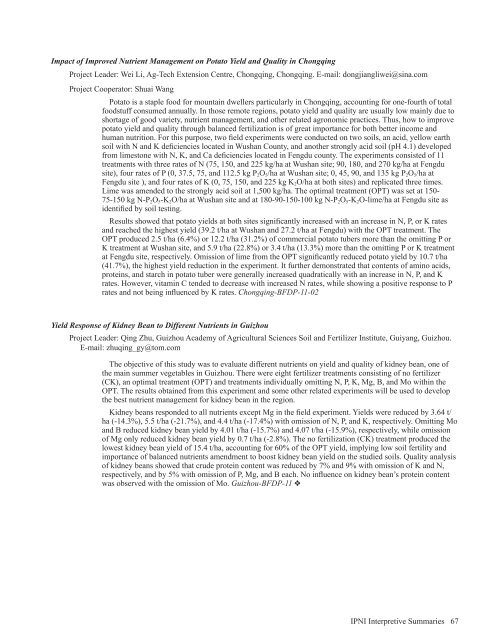Americas and Oceania Group - International Plant Nutrition Institute
Americas and Oceania Group - International Plant Nutrition Institute
Americas and Oceania Group - International Plant Nutrition Institute
You also want an ePaper? Increase the reach of your titles
YUMPU automatically turns print PDFs into web optimized ePapers that Google loves.
Impact of Improved Nutrient Management on Potato Yield <strong>and</strong> Quality in Chongqing<br />
Project Leader: Wei Li, Ag-Tech Extension Centre, Chongqing, Chongqing. E-mail: dongjiangliwei@sina.com<br />
Project Cooperator: Shuai Wang<br />
Potato is a staple food for mountain dwellers particularly in Chongqing, accounting for one-fourth of total<br />
foodstuff consumed annually. In those remote regions, potato yield <strong>and</strong> quality are usually low mainly due to<br />
shortage of good variety, nutrient management, <strong>and</strong> other related agronomic practices. Thus, how to improve<br />
potato yield <strong>and</strong> quality through balanced fertilization is of great importance for both better income <strong>and</strong><br />
human nutrition. For this purpose, two field experiments were conducted on two soils, an acid, yellow earth<br />
soil with N <strong>and</strong> K deficiencies located in Wushan County, <strong>and</strong> another strongly acid soil (pH 4.1) developed<br />
from limestone with N, K, <strong>and</strong> Ca deficiencies located in Fengdu county. The experiments consisted of 11<br />
treatments with three rates of N (75, 150, <strong>and</strong> 225 kg/ha at Wushan site; 90, 180, <strong>and</strong> 270 kg/ha at Fengdu<br />
site), four rates of P (0, 37.5, 75, <strong>and</strong> 112.5 kg P 2 O 5 /ha at Wushan site; 0, 45, 90, <strong>and</strong> 135 kg P 2 O 5 /ha at<br />
Fengdu site ), <strong>and</strong> four rates of K (0, 75, 150, <strong>and</strong> 225 kg K 2 O/ha at both sites) <strong>and</strong> replicated three times.<br />
Lime was amended to the strongly acid soil at 1,500 kg/ha. The optimal treatment (OPT) was set at 150-<br />
75-150 kg N-P 2 O 5 -K 2 O/ha at Wushan site <strong>and</strong> at 180-90-150-100 kg N-P 2 O 5 -K 2 O-lime/ha at Fengdu site as<br />
identified by soil testing.<br />
Results showed that potato yields at both sites significantly increased with an increase in N, P, or K rates<br />
<strong>and</strong> reached the highest yield (39.2 t/ha at Wushan <strong>and</strong> 27.2 t/ha at Fengdu) with the OPT treatment. The<br />
OPT produced 2.5 t/ha (6.4%) or 12.2 t/ha (31.2%) of commercial potato tubers more than the omitting P or<br />
K treatment at Wushan site, <strong>and</strong> 5.9 t/ha (22.8%) or 3.4 t/ha (13.3%) more than the omitting P or K treatment<br />
at Fengdu site, respectively. Omission of lime from the OPT significantly reduced potato yield by 10.7 t/ha<br />
(41.7%), the highest yield reduction in the experiment. It further demonstrated that contents of amino acids,<br />
proteins, <strong>and</strong> starch in potato tuber were generally increased quadratically with an increase in N, P, <strong>and</strong> K<br />
rates. However, vitamin C tended to decrease with increased N rates, while showing a positive response to P<br />
rates <strong>and</strong> not being influenced by K rates. Chongqing-BFDP-11-02<br />
Yield Response of Kidney Bean to Different Nutrients in Guizhou<br />
Project Leader: Qing Zhu, Guizhou Academy of Agricultural Sciences Soil <strong>and</strong> Fertilizer <strong>Institute</strong>, Guiyang, Guizhou.<br />
E-mail: zhuqing_gy@tom.com<br />
The objective of this study was to evaluate different nutrients on yield <strong>and</strong> quality of kidney bean, one of<br />
the main summer vegetables in Guizhou. There were eight fertilizer treatments consisting of no fertilizer<br />
(CK), an optimal treatment (OPT) <strong>and</strong> treatments individually omitting N, P, K, Mg, B, <strong>and</strong> Mo within the<br />
OPT. The results obtained from this experiment <strong>and</strong> some other related experiments will be used to develop<br />
the best nutrient management for kidney bean in the region.<br />
Kidney beans responded to all nutrients except Mg in the field experiment. Yields were reduced by 3.64 t/<br />
ha (-14.3%), 5.5 t/ha (-21.7%), <strong>and</strong> 4.4 t/ha (-17.4%) with omission of N, P, <strong>and</strong> K, respectively. Omitting Mo<br />
<strong>and</strong> B reduced kidney bean yield by 4.01 t/ha (-15.7%) <strong>and</strong> 4.07 t/ha (-15.9%), respectively, while omission<br />
of Mg only reduced kidney bean yield by 0.7 t/ha (-2.8%). The no fertilization (CK) treatment produced the<br />
lowest kidney bean yield of 15.4 t/ha, accounting for 60% of the OPT yield, implying low soil fertility <strong>and</strong><br />
importance of balanced nutrients amendment to boost kidney bean yield on the studied soils. Quality analysis<br />
of kidney beans showed that crude protein content was reduced by 7% <strong>and</strong> 9% with omission of K <strong>and</strong> N,<br />
respectively, <strong>and</strong> by 5% with omission of P, Mg, <strong>and</strong> B each. No influence on kidney bean’s protein content<br />
was observed with the omission of Mo. Guizhou-BFDP-11 v<br />
IPNI Interpretive Summaries 67

















